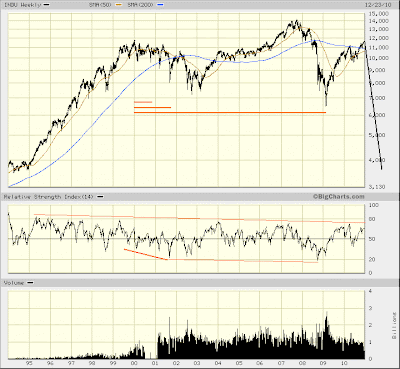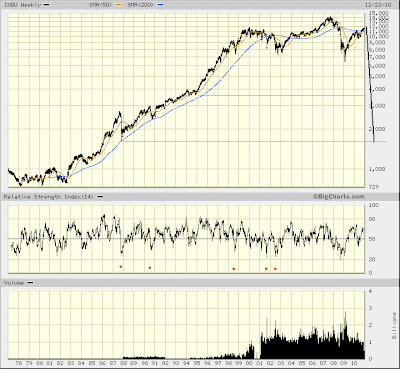Remaining as true now as in 2008 is the fact that, the Dow Jones Industrials Average could fall to 3600 tomorrow and still remain in a long-term uptrend. Appearing more likely right now, though, is this risk that, the market's long-term uptrend might be soon tested...

The Dow's price action since Y2k is seen forming a top — a view supported by persistently deteriorating relative strength over the years that, the great securitization Ponzi scheme has transitioned from an inflating wealth genie to an imploding debt trap. Over this same duration we also see that, as the Dow has fallen to lower lows, these consistently have been confirmed by weaker relative strength. Further price weakness ahead, then, appears signaled by this.
Support for this view that, significant weakness lies in store is gained looking closely at coincident relative strength, first during the market's '08 collapse, and then during its subsequent rally (still ongoing). Let's start with the latter...
Beyond the fact that, presently diverging relative strength (vs. April 2010) reveals underlying technical weakness making the market more vulnerable to contracting, there is the matter of relative strength's disposition during more or less the entirety of the market's advance off March '09 bottom. Observe how the Dow weekly's relative strength largely has been pasted to the positive side of its balance. This is most fitting a corrective wave unfolding amidst a larger decline yet to complete.
Back in the 2002-2003 period one important signal of an impending turn higher in the market came by both relative strength's positively improving divergences upon the Dow's successive retests of its lows at that time as well as relative strength's remaining to the negative side of its balance. This latter condition demonstrated that sufficient measure of fear restraining aggressive buying, such as might later be convinced to take shares off the hands of those supporting the market into March '03 bottom after these subsequently bid the market higher.
Simply in reverse might we consider relative strength's present circumstance. Much as its remaining to the negative side of its balance going into March '03 bottom during what proved a corrective wave within a larger move up was a positive signal, relative strength's present state — glued to the positive side of its balance — is seen a negative (and this most decidedly).
The market's levitation has come amidst a long-lasting imbalance of fearlessness whose greatest technical disparity simply is the fact that, 2008's collapse likely was not a correction-ending, panic-stricken capitulation. Rather, 2008 all too likely was but the beginning of an Elliott corrective wave, and so panic awaits.
Once again supporting evidence is presented via relative strength...

The five highlighted instances above mark relative strength coinciding with what are believed Elliott "c" waves. Now contrast October '07 - October '08. The market's decline over that duration was fairly orderly and balanced from a relative strength perspective. Hardly "c" wave-like (with the 1987 collapse particularly providing a useful contrast).
So, relative strength's behavior over these many months since October 2007 top supports my view that, the stock market presently is at risk of a sudden collapse dwarfing 2008. Just how many days more fearless levitation might last remains about the only open question. It could be just a few. The market's technical condition per several measures continues decidedly warning of trouble ahead.

* * * * *
© The Risk Averse Alert — Advocating a patient, disciplined approach to stock market investing. Overriding objective is limiting financial risk. Minimizing investment capital loss is a priority.
Analysis centers on the stock market's path of least resistance. Long-term, this drives a simple strategy for safely investing a 401(k) for maximum profit. Intermediate-term, investing with stock index tracking-ETFs (both their long and short varieties) is advanced. Short-term, stock index options occasionally offer extraordinary profit opportunities when the stock market is moving along its projected path.
Nothing is set in stone. Nor is the stock market's path of least resistance always known. More often than not, there are no stock index option positions recommended.
 There's an easy way to boost your investment discipline...
There's an easy way to boost your investment discipline...Get Real-Time Trade Notification!



















